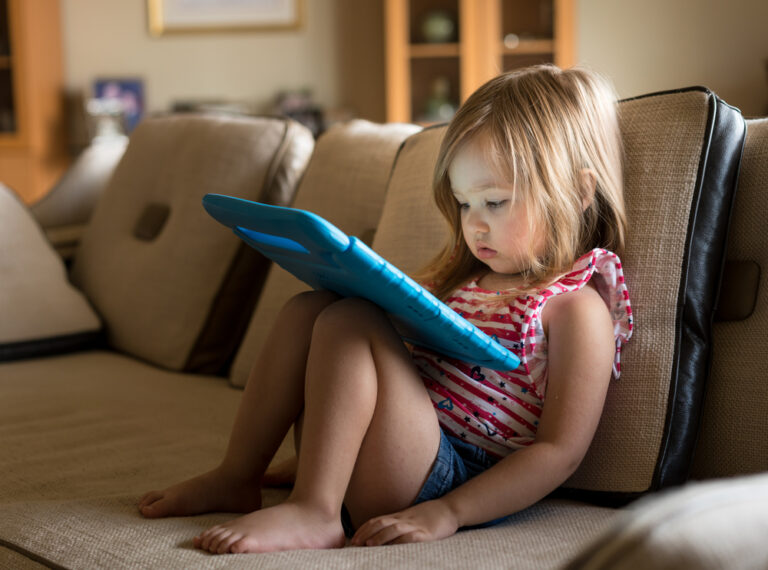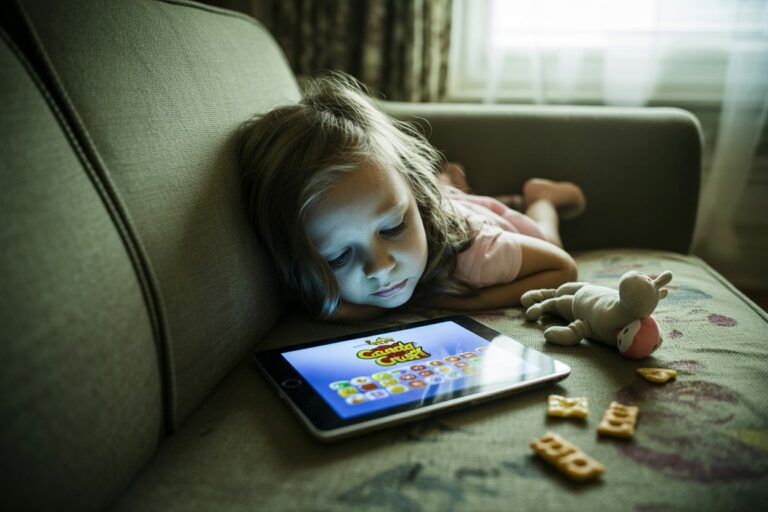
The Screen Time Paradox: Why Limiting Actually Increases the Problem
Traditional screen time limits don’t just fail – they actively make the problem worse. After analyzing hundreds of recent studies and expert opinions, the evidence is overwhelming: restricting screen time creates more family conflict, increases children’s desire for screens, and undermines their ability to self-regulate. The most effective approaches abandon time limits entirely in favor of collaborative, quality-focused strategies that treat children as partners rather than problems to be managed.
This isn’t just another opinion piece about parenting in the digital age. The psychological science is clear: when we restrict something children value, we trigger a phenomenon called psychological reactance – a motivational state that makes them want it even more. Meanwhile, 62% of families report regular conflicts over screen time, and despite widespread limit-setting, over half of teens still use screens 4+ hours daily. The traditional approach has failed, but research from 2020-2025 reveals surprising alternatives that actually work.
When psychology meets parenting: the forbidden fruit effect in action
The human brain is wired to want what it can’t have. Dr. Jenny Radesky, who leads screen time research at the University of Michigan and co-authored the American Academy of Pediatrics guidelines, doesn’t even set time limits on her own teenager’s phone. “I focus on quality rather than the overall amount of time,” she explains. Her reasoning is backed by robust psychological research showing that children whose parents forbid certain items show 71% higher emotional arousal when exposed to those items compared to children with more permissive access.
This “forbidden fruit effect” isn’t just theoretical. Eye-tracking studies from 2020 demonstrate that children from restrictive households literally can’t look away from prohibited items – their pupils dilate significantly more when seeing restricted content. The neurobiological explanation is even more concerning: restriction creates anticipatory dopamine spikes that can be larger than those experienced during actual screen use. When children’s brains start predicting when restrictions will end, they develop heightened craving states and more compulsive usage patterns. Dr. Dimitri Christakis from Seattle Children’s Hospital notes that modern technology is “actively working against our limit-setting” through psychological design features that exploit these exact neural pathways.
The enforcement challenge compounds the problem. Research shows that 71% of parents worry about screen time, yet studies document that “every single parent willfully undermines their own rules at some point.” This inconsistency teaches children that rules are negotiable and creates a cycle of conflict and guilt. Family therapists report that strict screen time limits have become the leading source of parent-child conflict, with 33% of families experiencing daily battles over device use. These fights don’t just fail to reduce screen time – they damage the parent-child relationship that research shows is the strongest protective factor against problematic media use.
Numbers that tell the real story of screen time failure
The data from recent large-scale studies paints a sobering picture of traditional approaches. Despite decades of public health messaging about screen time limits, 50.4% of teens now exceed 4 hours of daily screen time, with usage continuing to climb. Meta-analyses of 204 intervention studies found that screen time reduction programs achieve only minimal effects (effect size = 0.148), barely moving the needle on actual behavior change. Even more telling: shorter interventions with smaller samples show larger effects, but these don’t translate to real-world, sustainable change.
The pandemic provided an unfortunate natural experiment in screen time management. Global screen time increased 52% during lockdowns, jumping from 2.7 to 4.4 hours daily on average. But here’s the crucial finding: these increases correlated directly with family stress and loss of caregiver availability, not parental preferences or rule-breaking. When Kaiser Permanente tracked families post-pandemic, they found that 0.7 hours of the increase remained permanently elevated, suggesting that once screen habits form, traditional limits can’t reverse them.
Income disparities reveal another failure of the one-size-fits-all approach. Pew Research found that 47% of higher-income families report difficulty managing teen screen time compared to just 32% of lower-income families. This counterintuitive finding reflects how privileged children often have more devices, more privacy, and more sophisticated ways to circumvent restrictions. Meanwhile, authoritative parenting—characterized by warmth and appropriate expectations—reduces excessive screen time risk by 70%, while permissive parenting increases risk 4.5-fold. The message is clear: relationship quality matters far more than restriction quantity.
Expert consensus emerges: mentoring beats monitoring every time
Leading researchers have reached remarkable consensus on what doesn’t work – and what does. Dr. Michael Rich, who directs the Digital Wellness Lab at Boston Children’s Hospital, states bluntly: “Screen time limits never worked, even with television. And they can’t work now because we can’t even measure screen time.” His point reflects how seamlessly we now move between digital and physical worlds, making time-based restrictions an obsolete metric from a bygone era.
The American Academy of Pediatrics has quietly revolutionized its approach, moving from strict age-based time limits to a “5 Cs Framework” that prioritizes Content, Context, Child characteristics, Caregiver involvement, and Communication. This shift acknowledges what researchers have long known: four hours of educational content with parental engagement differs vastly from four hours of mindless scrolling. Dr. Radesky’s research confirms that “those four hours could be filled with something very educational and positive and affirming for that child, or it could be only two hours filled with something toxic.”
Digital wellness researcher Devorah Heitner champions “mentoring over monitoring,” drawing parallels to sex education: “Just as abstinence-only sex education doesn’t prevent teen pregnancy, keeping kids away from the digital world just makes them more likely to make bad choices once they do get online.” Her research with over 10,000 families found that “mentors” who guide children through technology use report far better outcomes than “limiters” who impose strict boundaries. These mentoring parents help children develop critical thinking about technology rather than simply restricting access.
Alternative approaches that create lasting change
The most effective strategies abandon time-based limits entirely in favor of collaborative, context-aware approaches. Joint Media Engagement (JME) research from the Joan Ganz Cooney Center demonstrates that children whose parents actively participate during screen time learn significantly more than those left alone with devices. This isn’t about surveillance – it’s about transforming screen time from isolated consumption into shared experience. Families practicing JME report not just better learning outcomes but stronger relationships and more natural transitions away from screens.
Family media agreements represent another evidence-based alternative. When children help create household rules, compliance rates soar. A randomized trial with 253 families found that collaborative media planning significantly improved rule engagement among adolescents. The key difference: these agreements focus on shared values and expectations rather than punishments. One successful family holds weekly meetings where children propose their own screen time goals and help design consequences for the whole family – including parents. After six months, they reported a 67% reduction in screen-related conflicts and improved family communication overall.
Perhaps most revolutionary is the shift from external to internal regulation. Research consistently shows that children who develop self-monitoring skills maintain healthier screen habits into adulthood than those subjected to external controls. Teaching children to recognize how different content affects their mood, sleep, and relationships proves far more effective than arbitrary time limits. Some families use “screen journals” where children track not minutes but feelings – noticing when gaming makes them angry or social media leaves them anxious. This awareness-building approach addresses the root cause rather than the symptom.
The paradox resolved: less control creates more balance
The research reveals a fundamental paradox: the more we try to control children’s screen time, the less control we actually have. Strict limits create psychological reactance, increase desire for screens, undermine self-regulation skills, and damage the family relationships that protect against problematic use. Meanwhile, families who abandon time limits in favor of quality-focused, collaborative approaches report better outcomes across every measure – less conflict, better content choices, stronger self-regulation, and healthier parent-child relationships.
The path forward isn’t permissiveness but partnership. Successful families treat technology as a tool rather than a threat, focusing on teaching children to make good choices rather than making choices for them. They model healthy habits instead of imposing hypocritical rules. They create screen-free zones and times that everyone respects rather than child-specific restrictions. Most importantly, they recognize that excessive screen use often signals unmet needs – for connection, stimulation, or escape – that no amount of restriction can address.
The evidence has spoken: traditional screen time limits represent an outdated solution to a modern challenge. The families finding success in our digital age are those brave enough to put down the timer and pick up the conversation. In doing so, they’re not just managing screen time – they’re raising children capable of managing themselves in an increasingly connected world. The question isn’t how many minutes our children spend on screens, but whether we’re equipping them with the wisdom to navigate technology throughout their lives. The research suggests that wisdom comes not through restriction, but through relationship, not through monitoring, but through mentoring.
References
Academic & Medical Journals:
- MDPI: A “Forbidden Fruit Effect”: An Eye-Tracking Study on Children’s Visual Attention to Food Marketing
- PubMed Central (NCBI): A “Forbidden Fruit Effect”: An Eye-Tracking Study on Children’s Visual Attention to Food Marketing
- PubMed Central (NCBI): Identifying effective intervention strategies to reduce children’s screen time: a systematic review and meta-analysis
- PubMed Central (NCBI): Associations between parenting styles and excessive screen usage in preschool children
- PubMed Central (NCBI): Effect of a Family Media Use Plan on Media Rule Engagement Among Adolescents: A Randomized Clinical Trial
- PubMed Central (NCBI): The Joint Media Engagement Scale (JMES): An instrument for measuring shared media use with children aged 1 to 5 years old
- Wiley Online Library: The impact of joint media engagement on parent–child interactions: A systematic review
- ScienceDirect: Screen time in children and youth during the pandemic: A systematic review and meta-analysis
- ScienceDirect: Screen time as an index of family distress
- British Psychological Society: The Joint Media Engagement Scale (JMES): An instrument for measuring shared media use with children aged 1 to 5 years old
- ACM Digital Library: Parent-Child Joint Media Engagement Within HCI: A Scoping Analysis of the Research Landscape
- American Academy of Pediatrics: Media and Young Minds
Government & Health Organizations:
- Centers for Disease Control and Prevention (CDC): Daily Screen Time Among Teenagers: United States, July 2021–December 2023
- Kaiser Permanente Division of Research: Children’s pandemic screen time rose nearly 2 hours per day
- CHOC – Children’s Health Hub: The effects of screen time on children: The latest research parents should know
Research Organizations & Educational Institutions:
- Pew Research Center: Screen time: US teens’ and parents’ experiences, approaches
- Joan Ganz Cooney Center: The New Coviewing: Investigating and Designing for Joint Media Engagement
- Digital Wellness Lab: Family Guide to Creating Shared Media Use Agreements
- Digital Wellness Lab: About Us – Michael Rich, MD, MPH
- Queen’s Gazette: Parenting approaches to help navigate family conflict over screen time
- University of Michigan Medicine: We’ve been asking the wrong questions about kids and screen time
- Dana Foundation: The Truth About Research on Screen Time
News & Media Outlets:
- NPR: Want to limit screen time for tweens? Parents’ own habits can make a difference
- TODAY.com: Kids And Phones: Expert Shares One Thing She Doesn’t Do
- The Boston Globe: 5 tips for raising healthier, screen-balanced kids according to the ‘media-trician’
- LiveNOW from FOX: Screen time for kids and teens: updated guidelines for parents released
- CBS 19 News: How long do parents spend fighting with their kids over screen time?
- EdTech Magazine: Here’s What the Research Says About Screen Time and School-Aged Kids
- Axios: The Digital Wellness Lab aims to mediate between TikTok and parents
Professional Organizations & Clinical Resources:
- American Association for Marriage and Family Therapy: Screening Screen Time: Evidence-Informed Guidelines for Parenting in the Digital Age
- TechDen: 62% of Families Experience Conflict Over Screen Time
- The Lavin Agency: Mentoring Kids Online: Alexandra Samuel on Digital Parenting in The Atlantic
- Children and Screens: Assessing Child Readiness for Tech | Jenny Radesky, MD
Psychology & Behavioral Research:
- Psychology Fanatic: Reactance Theory Explained: A Psychological Perspective
- Wikipedia: Reactance (psychology)
- Springer: Forbidden Fruit



